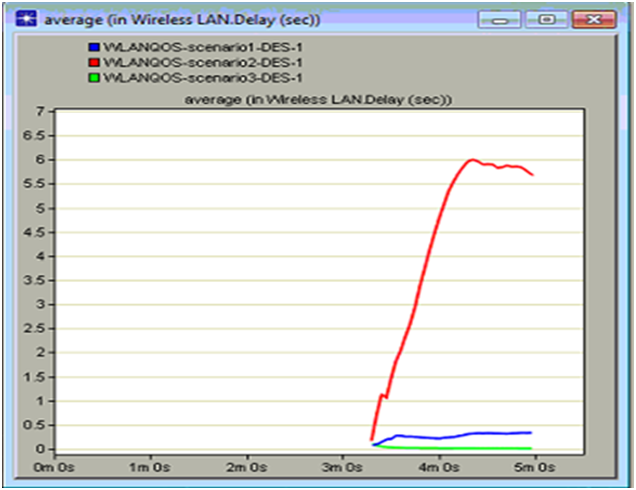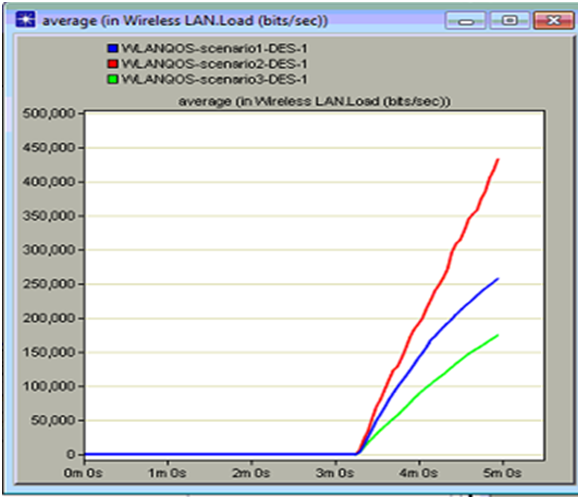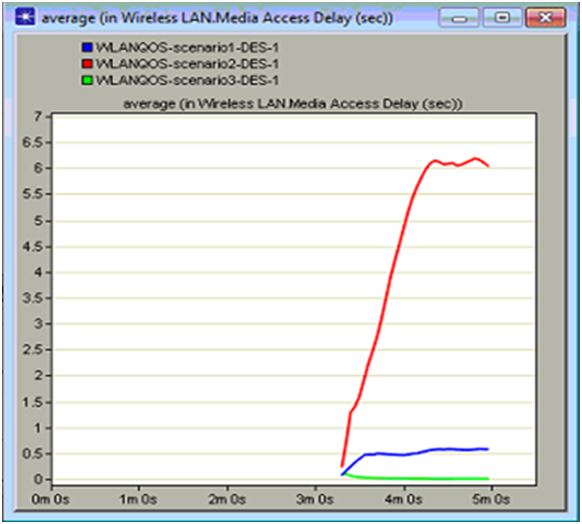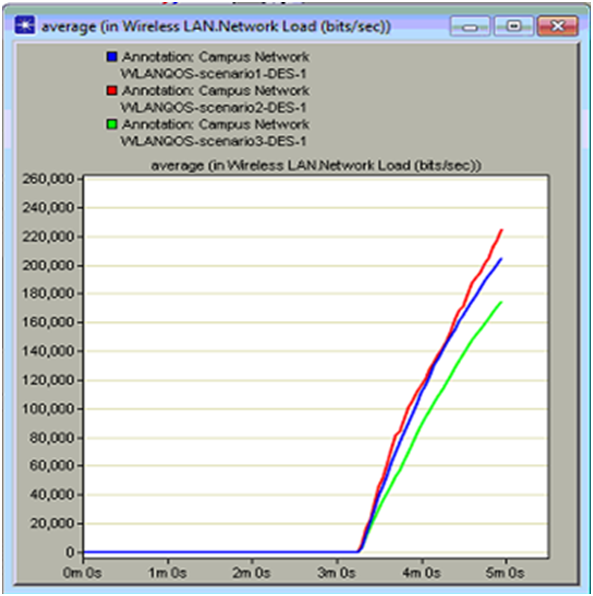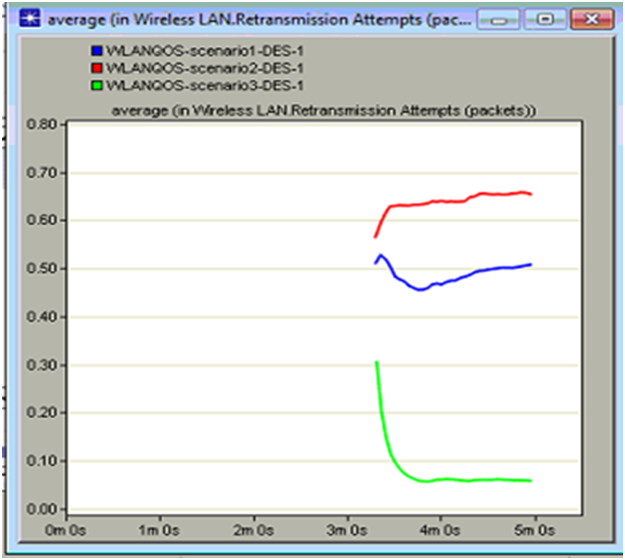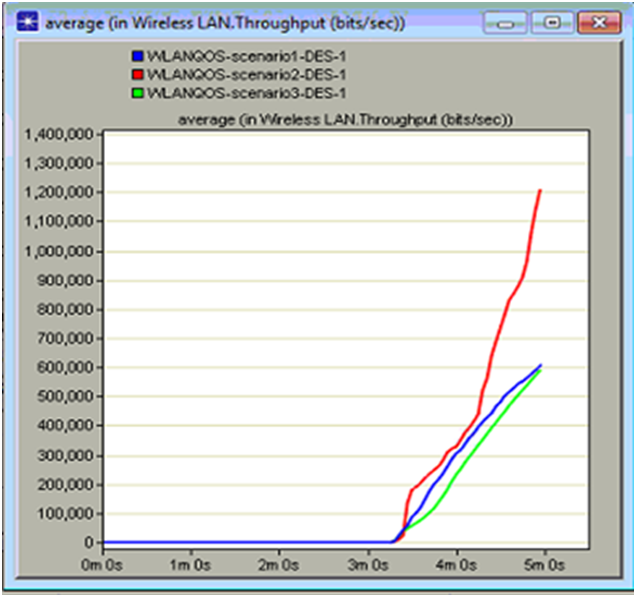Wireless LAN metrics
Wireless LAN metrics are also included in this simulation process to evaluate the performance of the voice applications. Few metrics that are suited for the quality of service requirements are considered in this performance evaluation and they are listed below
Delay in seconds
Delay has the significant role in estimating the quality of service requirements for the voice applications and thus in this context all the three scenarios are considered and the comparison results are given as below. Delay is the actual amount of time take by the packets to be transmitted from source to the destination and this delay indicates the overall packets transmitted to the server by the mobile nodes and if the delay is more the quality is reduced and in this context the comparison graph is as shown below
From the graph it is clear that the delay is more with the IP telephony application. When the delay incurred across the network is compared with the three scenarios is compared the overall delay is very less with the GSM speech and this indicates that the voice transmission is very fast at the GSM level and the highest value is more with the IP telephony and an optimal delay is incurred with the low quality speech. When a low quality speech is imposed across the voice the speech quality is increased due to the low noise across the network and the quality of service requirements are imposed due to the GSM quality speech on the network and thus the overall performance of the voice application is increased a lot due to the GSM application.
Load in bits per second
Load on the network also indicates the quality of service requirements across the voice application and in this context all the three scenarios are compared to evaluate the load on the network due to different applications on the network. If the load on the network is more then it indicates that the overall quality requirements are reduced a lot and the actual comparison graph is as shown below
From this graph it is clear that the load on the network is more with the IP telephony on the network and a less value is incurred across the GSM network. When the load is compared across the three scenarios it is clear that the overall load on the network is more when the IP telephony is considered as the required application and when the GSM is considered the load is reduced a lot and a maximum value is imposed which is very less than the other two scenarios. Low quality speech application is considered an optimal load on the network is imposed and thus from the overall analysis it is clear that the quality of service requirements is enhanced with the GSM quality speech.
Medium access delay in seconds
Medium access delay is the delay occurred across the medium that connect the mobile nodes and the server and this value also imposed the required quality of service requirements for the voice application. When this situation is considered all the three scenarios considered are compared and the resultant graph is shown below
When this graph is considered the medium access delay is more with the IP telephony. When the medium access delay is considered for the three scenarios the load is more with the IP telephony network and this due to the IP protocol implementation and this will reduce the quality of service on the network.
A minimum load on the network is imposed due to the GSM network and for this implementation the overall quality of service requirements against the voice application and even in this case the low quality speech also imposed the optimal medium access load on the network. From this overall analysis it is clear that to improve the quality of service across the voice applications GSM level standards are required and this fact is proved in this context.
Network load
Network load on the network indicates the overall load in terms of packets send and the congestion on the network and in this context the three scenarios are compared. First scenario holds the low quality speech, second scenario imposes the IP telephony and the third scenario indicates the GSM quality and the network load also plays an important role in estimating the quality of service across the voice applications and the resultant comparison graph is given below
From the above graph it is clear that the network load is more with the IP telephony when compared to the low quality speech and GSM quality speech. It is observed when the network load is considered more load on the network is imposed due to the IP telephony and this due to the fact the IP protocol is imposing more traffic on the network rather than the CBR traffic that was generated by the GSM and low quality speech.
GSM in general generated the CBR traffic where a constant traffic is directed towards the voice destination and thus the overall the network load on the network is reduced a lot. From this analysis it is clear that if GSM quality speech is used at the application level the impact on the quality of service requirements is directly adopted and it is increased a lot in this context.
Retransmission attempts
Retransmission attempts indicate the overall attempts made by the routing protocol to impose the quality of service requirements across the voice applications. If the retransmission attempts are more then it indicates that the packets are lost across the network due to the voice application is more and also the nodes and the server are losing the packets and they are attempting a new route request as they lost the core destination route to reach the voice destination and the corresponding scenario comparison graph is shown below
From the above graph it is clear that the overall retransmission attempts is more with the IP telephony when compared with the other scenarios. It can be observed that the overall retransmission attempts made by the GSM quality is very less when compared to the IP telephony and the low quality speech and this indicates that the GSM is best suited to ensure the quality of service requirements and also the case of losing the packets is reduced a lot as the attempts made due to lose of the route is very less.
When the case with the IP telephony is considered the retransmission attempts are very more and a maximum value of 0.65 is recorded and this indicates that the quality of speech is suppressed and also the optimal conditions are violated. Thus from this overall analysis it is clear the total retransmission attempts are reduced due to the GSM quality aspects and thus the overall performance is improved at the same time against the quality of service requirements.
Throughput
Throughput indicate the quality of service requirements for the voice application in terms of overall network performance and in this context all the three scenarios considered are evaluated after the simulation for 5 minutes and the corresponding resultant graph is as shown below
From the above graph it is clear that the overall throughput is more with the IP telephony as the delay in the packet delivery is more. When the throughput is more the quality of service is reduced a lot and thus in this context the GSM quality voice application is imposing a very less throughput and thus the quality is improved in this context where the maximum throughput is due to the IP telephony as the IP protocol impose more traffic on the network and due to this the overall throughput is increased.
When the case with the low quality speech is considered an optimal throughput is occurred and due to this the overall voice performance is reduced a lot. From the overall analysis of the results it is clear that the quality of service across the voice applications can be improved with the GSM quality voice application.

